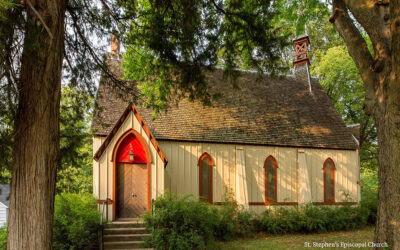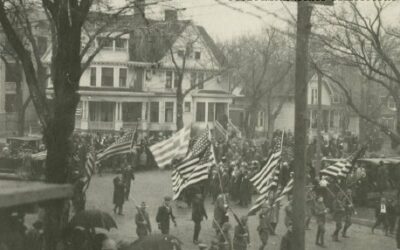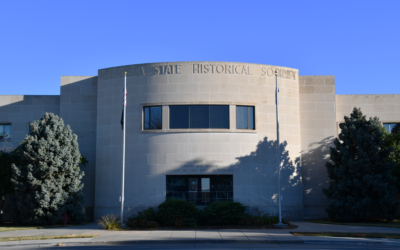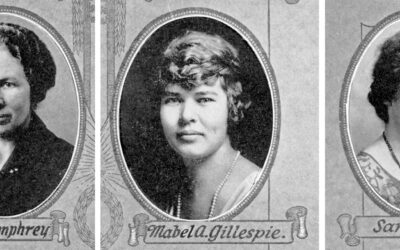Collecting and studying military insignia for years, Mark D. Hunt found an obscure bronze medal that led him to research Nebraska’s involvement in the United States’ Mexican Expedition of 1916.
By Breanna Fanta, Editorial Assistant
 For over 30 years, Mark D. Hunt has collected and studied military insignia. An obscure bronze medal led him to research Nebraska’s involvement in the United States’ Mexican Expedition of 1916. In Hunt’s full story, “Nebraska Mexican Border Service Medal” in the Nebraska History Magazine’s Spring 2021 issue, he explains the service of Nebraska’s National Guard and the events leading to the creation of the medal.
For over 30 years, Mark D. Hunt has collected and studied military insignia. An obscure bronze medal led him to research Nebraska’s involvement in the United States’ Mexican Expedition of 1916. In Hunt’s full story, “Nebraska Mexican Border Service Medal” in the Nebraska History Magazine’s Spring 2021 issue, he explains the service of Nebraska’s National Guard and the events leading to the creation of the medal.
March 9, 1916, the small town of Columbus, New Mexico, which was guarded by a garrison of troops, fell under attack. For unknown reasons, Mexican Revolutionary General “Pancho” Villa and his men targeted Columbus in the night.
(Nebraska Mexican Border Service Medal. Author’s collection)
For 90 minutes, buildings were set ablaze and the community was caught in a rain of bullets.
Following this attack, President Woodrow Wilson called for the mobilization of Texas, Arizona, and New Mexico’s National Guard units, along with an additional 110,000 other National Guardsmen.
The Nebraska National Guard was called into service that June. It was comprised of the 4th and 5th Regiment, with 2,000 servicemen combined. By July, Governor John H. Morehead ordered them to assemble at the State Fairgrounds in Lincoln. Those who met the physical requirements were loaded onto trains for Camp Llano Grande in Mercedes, Texas.
While stationed there, the guardsmen completed daily inspections, marching, drills, instructions, and target practices in hot and sandy conditions.
By 1917, the United States no longer saw Villa as a threat and prepared to enter World War I. On New Year’s Eve, Nebraska’s 4th Regiment arrived at Omaha’s Fort Crook. Upon their return, the army ordered that all equipment and uniforms be collected, but this created an uproar. Many of the men had purchased parts of their uniforms and personal equipment with their own money. The men gathered a load of uniforms and equipment to shred and burn. The governor then negotiated a compromise that allowed each soldier to keep one good uniform to wear home, but all other items had to be returned.
Once Nebraska’s 4th Regiment was discharged, the 5th followed suit in February. That spring, the governor asked the legislature to pass a bill to awarding medals in recognition of the guardsmen’s border service. The bill was amended to reimburse each soldier $75 for damaged clothing kept in Ft. Crook’s “musty lockers.”
In total, 1,700 Mexican Border Service Medals were produced. As a large percentage of the National Guardsmen were by then stationed in New Mexico awaiting overseas deployment, some of the medals were delivered there. However, recipients weren’t allowed to wear them as “federal regulations forbid the wearing of any state medal while in the federal service.”
Today, the Nebraska National Guard Museum in Seward has over 200 of these service medals. Why are there so many unissued medals? Many wonder if they simply weren’t claimed, or if some recipients died between the time of their service and the time when the medals became available.
Regardless, the medal commemorates an important moment on the eve of US entry into World War I. They deployment was meant to protect the border, but it also provided the Nebraska National Guard with valuable experience prior to their overseas deployment. Hunt concludes that the medals remain a treasured part of Nebraska’s history.
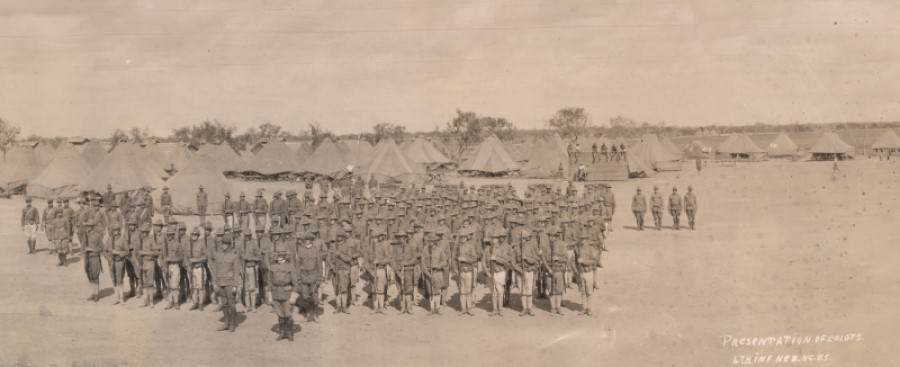
(Presentation of colors, 4th Infantry, Nebraska National Guard, at Llano Grande, Texas, October 23, 1916. RG1596-0-34)
The entire article can be found in the Spring 2021 edition of the Nebraska History Magazine. Members receive four issues per year.
Categories:
Nebraska National Guard, Border, New Mexico, Fort Crook

